Roden 1/32nd Fokker Dr.I
|
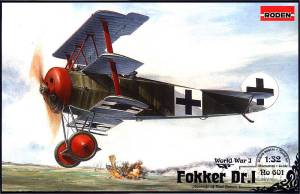 |
In a very odd coincidence I started to
write this on the 87th anniversary of the death of Rittmeister Manfred
Albrecht Freiherr von Richthofen.
At last, Roden has filled a too long, empty void in the plastic modeling
world with the release of an absolutely beautiful Fokker Dr.I in 1:32
scale.
The Fokker Dr.I
 When
you talk to someone who is not an aviation fan, you will find that there
are "benchmark" airplanes known to the general population, that
have taken on legendary status. Most folks can identify a Piper Cub (well
any small high wing airplane is a Piper Cub to most of them), the GB R1,
and the Boeing 747. When
you talk to someone who is not an aviation fan, you will find that there
are "benchmark" airplanes known to the general population, that
have taken on legendary status. Most folks can identify a Piper Cub (well
any small high wing airplane is a Piper Cub to most of them), the GB R1,
and the Boeing 747.
For WW-I aviation the most identified
airplane is the all-red/crimson Fokker Dr.I triplane of the "Red
Baron". Again paint any triplane/biplane red, and it was flown by
the Red Baron, which was a moniker applied to Manfred Albrecht Freiherr
von Richthofen only after his death. Fortunately for us, it is this slight
bit of knowledge in the general population that gives us models that will
sell. As an example of this, the only other big Dr.I, Revell's 1:28 scale
kit has been around since the late '50s or early '60s. It is still being
produced every few years.
A Google search for Fokker Dr.I will give
dozens of excellent sites dedicated to the history and preservation of
this aircraft. My favorite is here: Welcome
To Fokker DR1.com - Research on the Fokker Dr.I These folks are attempting
to photographically identify each of the 320 Dr.Is that were built. At
this time their record stands at 76 (24%) not bad, considering we're looking
for photographs that are at least 86 years old!
 A
compressed history: In 1917, the German pilots had started to encounter
a new three-winged variant of the Sopwith Pup - The Sopwith Triplane.
This allied triplane was able to out-turn the best of the German Albatros
fighters, and subsequently the triplane was shooting more of the Albatros'
down! A call went out to the German aviation manufacturers to develop
their own triplane to counter this new English threat. The famous "let's
build one to counter theirs" military plan that continues to this
day. A
compressed history: In 1917, the German pilots had started to encounter
a new three-winged variant of the Sopwith Pup - The Sopwith Triplane.
This allied triplane was able to out-turn the best of the German Albatros
fighters, and subsequently the triplane was shooting more of the Albatros'
down! A call went out to the German aviation manufacturers to develop
their own triplane to counter this new English threat. The famous "let's
build one to counter theirs" military plan that continues to this
day.
Several of the designers followed Sopwith's
lead and simply slapped three wings on an existing biplane fuselage. But
Fokker went in a different direction and started with a clean sheet of
paper. (Sound of a foot stomping on the floor, as in pay attention, this
is important!) He chose a radically new approach for the new wing, a very
fat, relatively short span, internally braced wing that eliminated the
need for drag producing flying wires. He introduced the cantilevered wing,
the design we consider "normal" to this day.
The concept behind the design is that
if you keep the wingspan short enough, you will keep the bending loads
low, and you no longer need flying wires. But with a short wing you still
have to have enough surface area to fly on, thus add more wings! The result
was a stubby little three-winged prototype called the Fokker V.4.
Fokker had so much faith in the cantilever
design that there weren't even struts between the outer ends of the wingtips.
That quickly changed because the wings flexing 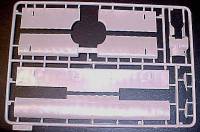 in
opposite directions stressed (unnerved, scared, terrified-you get the
idea) the test pilots. In the end the little fighter went through several
identifiers before it was accepted; first it was a production version
prototype the V.5, then for a short while the Fokker D-VI, then, lastly,
was accepted as the Fokker F.I. in
opposite directions stressed (unnerved, scared, terrified-you get the
idea) the test pilots. In the end the little fighter went through several
identifiers before it was accepted; first it was a production version
prototype the V.5, then for a short while the Fokker D-VI, then, lastly,
was accepted as the Fokker F.I.
At first only three pre-production aircraft
F.I 101/17, 102/17 and 103/17 were accepted by the German military. The
latter two aircraft went off to the front for combat evaluation. F.I 101/17
was retained by Fokker for testing. F.I 102/17 went to Jasta 11 on 21
August 1917, and became the personal mount of Rittmeister Manfred Freiherr
von Richthofen. Unfortunately for von Richthofen, the aircraft was being
flown by Ltn Kurt Wolff, who was shot down on 15 September 1917 (just
25 days later).
F.I 103/17 went to Jasta 10 on 21 August
1917, and became the personal mount of Werner Voss. He lost his life on
23 September 1917 (just 33 days later) while single-handedly taking on
no fewer than seven RAF SE-5a aircraft in this same aircraft. Not a very
auspicious start for our stubby little fighter.
Several minor changes in the production
line again changed the official designation to Dr.I, the obvious contraction
for the German Driedeker, or three-winged aircraft. The noticeable changes
on the Dr.I was the elimination of a gentle curve in the leading edge
of the horizontal stabilizer, enlarging of the counter balances on the
elevator, and adding axe handles to the bottom of the lower wings to act
as  skids,
minimizing damage to the wing in the event of dragging a wingtip. skids,
minimizing damage to the wing in the event of dragging a wingtip.
The only other changes notable in the
Dr.I production run were slight variations in the engine cowl configurations,
and there were two slightly different configurations of aileron. The first
Dr.I captured and evaluated by the allies had one of each of these different
ailerons simply due to the fact the old one was broken and the new, different
shaped one, fit. This, for years, lead to a misbelief that all of the
Dr.Is had asymmetric ailerons to counteract engine torque, when in reality
it was just a logistics fluke.
In all only 320 F.Is & Dr.Is were
delivered. They served in the front lines from 20 October 1917 until June
of 1918 when they were replaced by Albatros, Pfalz and other Fokker fighters.
There was a brief time out of service when all of the Dr.Is were grounded
due to faulty workmanship in the wings, compounded by water entrapment,
which caused the wings to fall apart in flight. Anthony Fokker was forced
to replace all of the wings in service out of his company's own profit.
The Dr.Is continued to serve in fighter schools to the end of the war.
The Kit
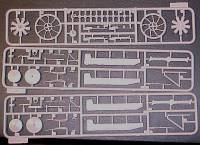 Every
so often, one has to take a moment and laugh at our hobby. I consider
it a privilege to receive a kit from IM and the manufacturer to build
for a review. In this case, Roden sent the evaluation copy to IM at the
same time the first shipment of kits was hitting the hobby store shelves.
In my kits' case, it came in a box with another Roden kit I'd volunteered
to evaluate. Both kits were "knocked down" their boxes were
not assembled, and the lids were flat, and the bags of parts and decals
were floating free in a larger box. So, in order to start the evaluation
of this kit, I had to assemble from a pile of kit parts to make a kit,
just to have an example of the kit to review. Never mind, it's late. Every
so often, one has to take a moment and laugh at our hobby. I consider
it a privilege to receive a kit from IM and the manufacturer to build
for a review. In this case, Roden sent the evaluation copy to IM at the
same time the first shipment of kits was hitting the hobby store shelves.
In my kits' case, it came in a box with another Roden kit I'd volunteered
to evaluate. Both kits were "knocked down" their boxes were
not assembled, and the lids were flat, and the bags of parts and decals
were floating free in a larger box. So, in order to start the evaluation
of this kit, I had to assemble from a pile of kit parts to make a kit,
just to have an example of the kit to review. Never mind, it's late.
Markings
In
the case of Roden kit number 601, Roden continues its road to producing
high quality WW-I model airplanes. The box art represents Rittmeister
Manfred von Richthofen's Dr.I 477/17; an aircraft that is mostly streaked
green, with red trim on the wing, engine and tail. Other finishing options
show on the plans and included in the decal sheet are for 586/17 a black
and white streaked Dr.I flown by Ltn. Ernst Udet; a green streaked black
and white trimmed 213/17 flown by Ltn. Freidrich Kempf; and the all black
"god of the north wind" 450/17 flown by Ltn. Joseph Carl Jacobs.
Parts and Pieces
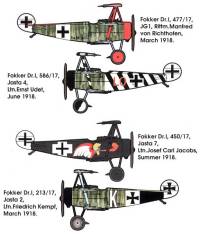 The
kit comes with seven light brown/khaki very nicely done sprues holding
a total of 100 (my count on the sprue) parts. Included in this parts count
are the alternate horizontal stabilizer and elevator for the F.I versions
of the aircraft. Other options are a pair of machine guns that are molded
to accept a PE cooling jacket, but this first version of the kit omits
PE entirely. There is also a choice of two different propellers. The engine
alone consists of 16 parts, featuring each cylinder head molded as a separate
part. The
kit comes with seven light brown/khaki very nicely done sprues holding
a total of 100 (my count on the sprue) parts. Included in this parts count
are the alternate horizontal stabilizer and elevator for the F.I versions
of the aircraft. Other options are a pair of machine guns that are molded
to accept a PE cooling jacket, but this first version of the kit omits
PE entirely. There is also a choice of two different propellers. The engine
alone consists of 16 parts, featuring each cylinder head molded as a separate
part.
There is an extensive amount of detail
for the interior representing the fuselage structural tubing and all of
visible parts. My first personal disappointment is that the inside fuselage
has two huge ejector towers on each side, one of which, is exactly in
line with the cockpit opening.
Also the side fairing from the engine
to the fuselage of the Dr.I were fairly large, very prominent triangular
shaped plywood skins trapped between the steel framing and the fabric
skin. Roden has chosen not to mold these into the fuselage. Although it
just dawned on me that these are ideal pieces to add as PE at a later
date.
Some
early problems
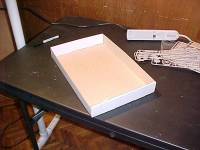 Already
some other relatively minor discrepancies have begun to show up
on Internet sites from early builders. There appears to be some mis-numbering
between the parts and the plans. Specifically the upper-wing tips are
parts 7A, and 8A, and the mid-and lower-wing tips are 10D & 11D. The
instructions start by calling for the installation of a part 11D at each
end of the upper-wing, then 7A and 8A at each end of the mid-wing, ending
with a part 11D at each end of the lower-wing. The correct configuration
should be 7A and 8A respectively at the right and left upper-wing tips,
followed by 10D and 11D, respectively at the right and left mid- and lower-wing
tips. Already
some other relatively minor discrepancies have begun to show up
on Internet sites from early builders. There appears to be some mis-numbering
between the parts and the plans. Specifically the upper-wing tips are
parts 7A, and 8A, and the mid-and lower-wing tips are 10D & 11D. The
instructions start by calling for the installation of a part 11D at each
end of the upper-wing, then 7A and 8A at each end of the mid-wing, ending
with a part 11D at each end of the lower-wing. The correct configuration
should be 7A and 8A respectively at the right and left upper-wing tips,
followed by 10D and 11D, respectively at the right and left mid- and lower-wing
tips.
I also disagree with some of the
color callouts that Roden specifies in the instructions. In this case,
they call for OD green on the sides and upper surface in the interior
of the fuselage, and wood for the bottom panels. In my opinion, the whole
should be a linen color. The bottom of the Dr.I was just fabric covering
over the tube frame. All of the fabric received several coats of clear
dope to taughten it to the drum tight finish needed. Then the OD streaky
paint was applied. The clear dope would have prevented the colored dope
from staining the inside surface so it would have remained linen colored.
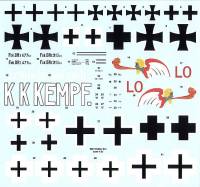 Again
all of these complaints are extremely minor and can be easily rectified. Again
all of these complaints are extremely minor and can be easily rectified.
And the good news!
At last we have a 1:32 Fokker Dr.I to fill a too long empty hole the
kit collection. It's a good kit, looking
to be much easier to build than most WW-I topics. The details are great
and there are no starving cows on the fabric wings. There has been much,
too much controversy on just how doped fabric should look like on open
framed wooden wing. In this case I think Roden got it just right!
Again I'd like to thank Roden,
I.M. and Matt Bittner for the opportunity to do this review and build.
|
|
